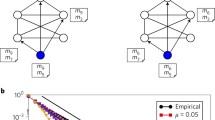Abstract
Social computing focuses on the interaction between social behavior and information, especially on how the latter propagates across social networks and is consumed and transformed in the process. At the same time the ubiquity of information has left it devoid of much monetary value. The scarce, and therefore valuable, resource is now attention, and its allocation gives rise to an attention economy that determines how content is consumed and propagated. Since two major factors involved in getting attention are novelty and popularity, we analyze the role that both play in attracting attention to web content and how to prioritize them in order to maximize it. We also demonstrate that the relative performance of strategies based on prioritizing either popularity or novelty exhibit an abrupt change around a critical value of the novelty decay time, resembling a phase transition.






Similar content being viewed by others
References
Franck, G.: Science communication, a vanity fair. Science 286, 53–55 (1999)
Klamer, A., Dalen, H.P.V.: Attention and the art of scientific publishing. J. Econ. Methodol. 9, 289–315 (2002)
Wu, F., Huberman, B.A.: Popularity, novelty and attention. In: Proceedings of the 2008 ACM Conference on Electronic Commerce, 2008
Szabo, G., Huberman, B.A.: Predicting the popularity of online content. Commun. ACM 8, 80–88 (2010)
Falkinger, J.: Attention economies. J. Econ. Theory 133, 266–294 (2007)
Garofalakis, J., Kappos, P., Mourloukos, D.: Web site optimization using page popularity. IEEE Internet Comput. 3(4), 22–29 (1999)
Hong, W., Thong, J.Y.L., Tam, K.Y: Does animation attract online users attention? The effects of flash on information search performance and perceptions. Inf. Syst. Res. 15(1), 60–86 (2004)
Huberman, B.A., Pirolli, P.L.T., Pitkow, J.E., Lukose, R.M.: Strong regularities in world wide web surfing. Science 280(5360), 95–97 (1998)
Niño-Mora, J.: Stochastic scheduling. In: Floudas, C.A., Pardalos, P.M. (eds.) Encyclopedia of Optimization, vol. V, pp. 367–372 (2001)
Wu, F., Huberman, B.A.: The economics of attention: maximizing user value in information-rich environments. In: The First International Workshop on Data Mining and Audience Intelligence for Advertising (ADKDD’07), 2007
Wu, F., Huberman, B.A.: Novelty and collective attention. Proc. Natl. Acad. Sci. 104(45), 17599–17601 (2007)
Zhang, P.: The effects of animation on information seeking performance on the world wide web: securing attention or interfering with primary tasks? AIS 1(1) (2000)
Author information
Authors and Affiliations
Corresponding author
Rights and permissions
About this article
Cite this article
Huberman, B.A. Social Computing and the Attention Economy. J Stat Phys 151, 329–339 (2013). https://doi.org/10.1007/s10955-012-0596-5
Received:
Accepted:
Published:
Issue Date:
DOI: https://doi.org/10.1007/s10955-012-0596-5




